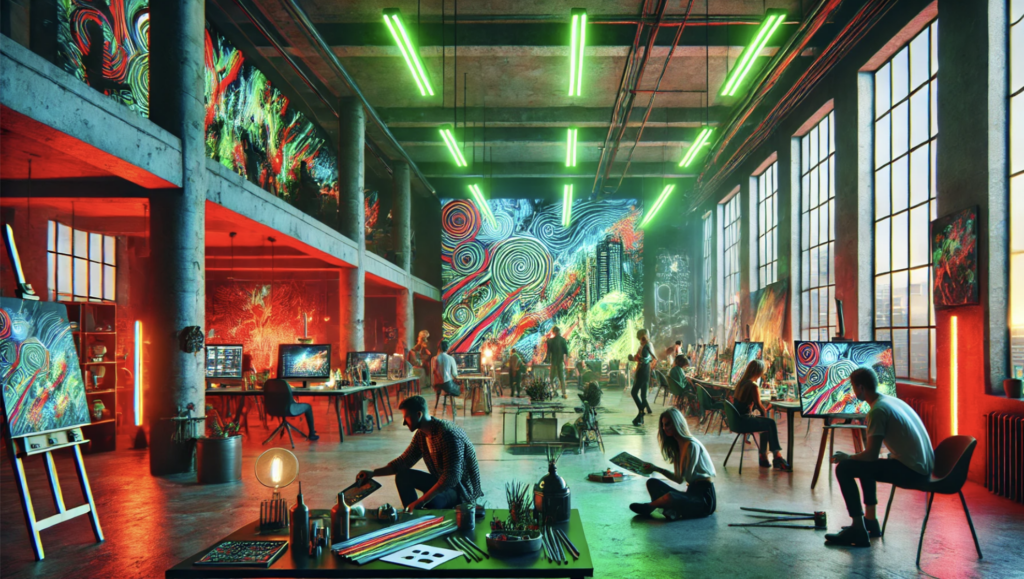In today’s business landscape, the convergence of art and business innovation is becoming increasingly evident.
As companies seek to differentiate themselves in a crowded marketplace, the infusion of artistic principles and creativity into business practices is emerging as a powerful catalyst for unique and effective innovations.
This intersection not only fosters originality and distinctiveness but also enhances problem-solving abilities, nurtures a culture of innovation, and ultimately drives business success.
Here, we explore how embracing artistic principles can revolutionize business practices and lead to groundbreaking innovations.
The Role of Artistic Principles in Business
Artistic principles such as creativity, risk-taking, and emotional engagement are essential components of artistic practice and are equally valuable in the business context.
These principles encourage thinking beyond conventional boundaries and embracing new perspectives, which are critical for innovation.
1. Creativity and Imagination
At the heart of both art and innovation lies creativity.
Artistic creativity involves seeing the world in novel ways, making connections between seemingly unrelated concepts, and expressing ideas uniquely.
Similarly, in business, creativity is the bedrock of innovation.
Companies that foster a culture of creativity encourage employees to think outside the box, leading to the development of innovative products, services, and processes.
For example, tech giant Google encourages its employees to spend 20% of their time on projects they are passionate about, even if these projects are not directly related to their job responsibilities.
This policy has led to the creation of groundbreaking products such as Gmail and Google News, showcasing the power of creativity in driving business innovation.
2. Risk-Taking and Experimentation
Artistic endeavors often involve taking risks and experimenting with new techniques or materials.
This willingness to venture into the unknown and embrace failure as part of the creative process is equally important in business innovation.
Companies that adopt a similar approach are more likely to discover groundbreaking solutions and stay ahead of the competition.
A prime example is the approach taken by the design firm IDEO, known for its innovative design thinking methodology.
IDEO encourages rapid prototyping and iteration, where failure is seen as a learning opportunity rather than a setback.
This philosophy has enabled them to develop innovative solutions for a wide range of clients, from healthcare to consumer products.
3. Emotional Engagement and Storytelling
Art has the unique ability to evoke emotions and tell compelling stories.
In the business world, emotional engagement and storytelling can be powerful tools for building strong brands and connecting with customers on a deeper level.
Companies that effectively incorporate storytelling into their marketing strategies can create more memorable and impactful experiences for their audience.
Apple is a master of this approach, using storytelling to create an emotional connection between its products and consumers.
Their advertising campaigns often focus on the human experiences and emotions associated with using Apple products, rather than just the technical specifications.
This strategy has helped Apple build a loyal customer base and maintain a strong brand identity.
Fostering a Culture of Innovation through Artistic Principles
Incorporating artistic principles into business practices requires a deliberate effort to cultivate a culture of innovation.
Here are some strategies for embedding these principles into the organizational fabric:
1. Encouraging Creative Thinking
To foster creativity, businesses should create an environment where creative thinking is encouraged and valued.
Discussing different perspectives and ideas can further enhance creativity.
2. Promoting Collaborative Innovation
Collaboration is a cornerstone of both artistic creation and business innovation.
An example of successful collaborative innovation is the partnership between Starbucks and Airbnb.
By leveraging their respective strengths, the two companies co-created unique experiences for customers, such as curated coffee-tasting events hosted at Airbnb properties.
This collaboration not only provided value to their customers but also reinforced their brand identities.
3. Embracing Failure as Part of the Process
In both art and business, failure is an inevitable part of the journey toward innovation.
Companies should create a space for experimentation where failure is seen as a learning opportunity rather than a cause for punishment.
This can be achieved by celebrating successful failures – those that provide valuable insights and lead to future success.
For instance, the consumer goods company Procter & Gamble has a “Failure Wall” where employees share their failures and the lessons learned.
This initiative encourages a culture of experimentation and continuous improvement, ultimately driving innovation across the organization.
Case Studies: Art and Business Innovation in Action
1. The Walt Disney Company
The Walt Disney Company is a prime example of how artistic principles can drive business innovation.
From its inception, Disney has combined:
- Storytelling
- Creativity
- And tech
to create magical experiences for its audience.
The company’s:
- Theme parks
- Animated films
- And merch
are all products of a culture that values artistic creativity and innovation.
Disney’s Imagineering team, responsible for designing theme parks and attractions, epitomizes the fusion of art and tech.
By combining imaginative storytelling with cutting-edge tech, Disney continues to set new standards in the entertainment industry.
2. Pixar Animation Studios
Pixar Animation Studios is another organization that exemplifies the integration of art and business innovation.
Known for its groundbreaking animated films, Pixar fosters a culture of creativity and collaboration.
The studio’s open office layout encourages spontaneous interactions and idea-sharing among employees, leading to innovative storytelling and tech advancements.
Pixar’s success is also attributed to its iterative process of filmmaking.
Through constant feedback and refinement, the studio ensures that each film meets its high standards of quality and creativity.
This approach has resulted in numerous critically acclaimed and commercially successful films.
Conclusion
The intersection of art and business innovation offers a powerful framework for companies seeking to differentiate themselves in today’s competitive landscape.
By embracing artistic principles such as:
- Creativity
- Risk-taking
- And emotional engagement
businesses can unlock new opportunities for growth and innovation.
Fostering a culture that values:
- Creative thinking
- Collaborative innovation
- And the acceptance of failure as part of the process
is key to integrating these principles into business practices.
As demonstrated by companies like Google, Disney, and Pixar, the fusion of art and business innovation can lead to unique and effective solutions that captivate audiences and drive success.
By continuing to explore and embrace this intersection, businesses can stay ahead of the curve and navigate the ever-evolving market with creativity and confidence.
Want to learn more?
You May Also Like:
How To Make An Offer They Can't Refuse: Vito Corleone
Why 95% of Brands Don’t Need a Face - And Neither Does Yours
The Secret to Charging Premium Prices
Crafting a Powerful Brand Identity: Strategies for Success
The X Factor in Communication: Why Trust Outweighs Content
Exclusive Multi-Millionaire Success Stories: Cybersecurity Entrepreneur
Experts Say: This Is the Most Low-Risk Business to Start Today
How to Build an Empire Without Anyone Knowing - The Forbidden Guide
My name is Mister Infinite. I've written 600+ articles for people who want more out of life. Within this website you will find the motivation and action steps to live a better lifestyle.


